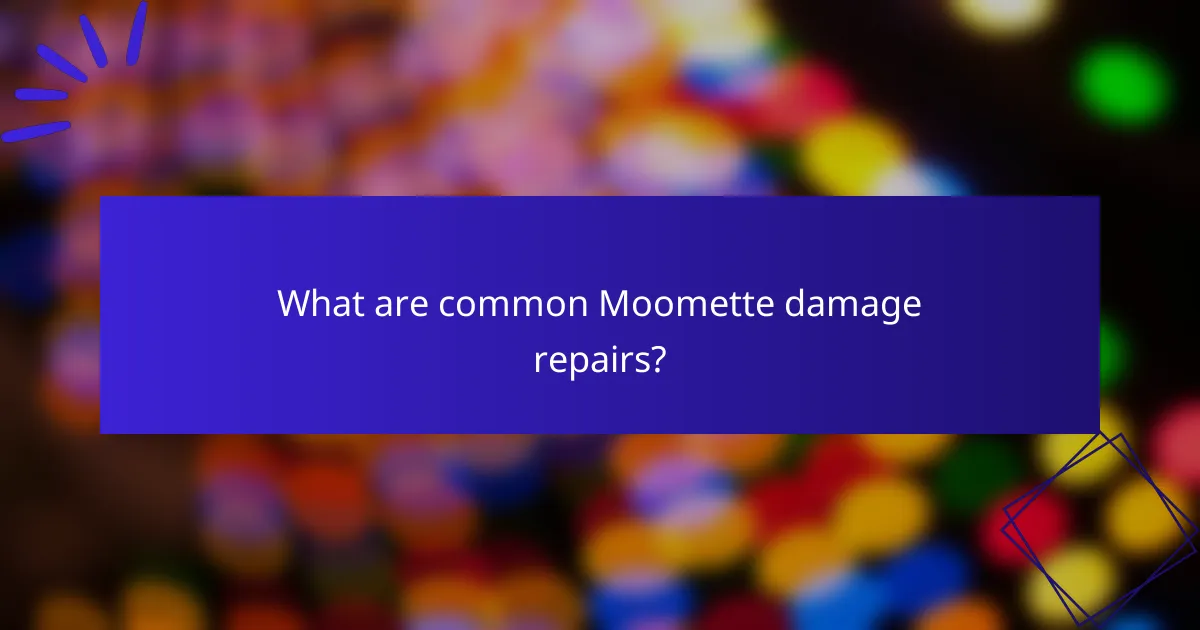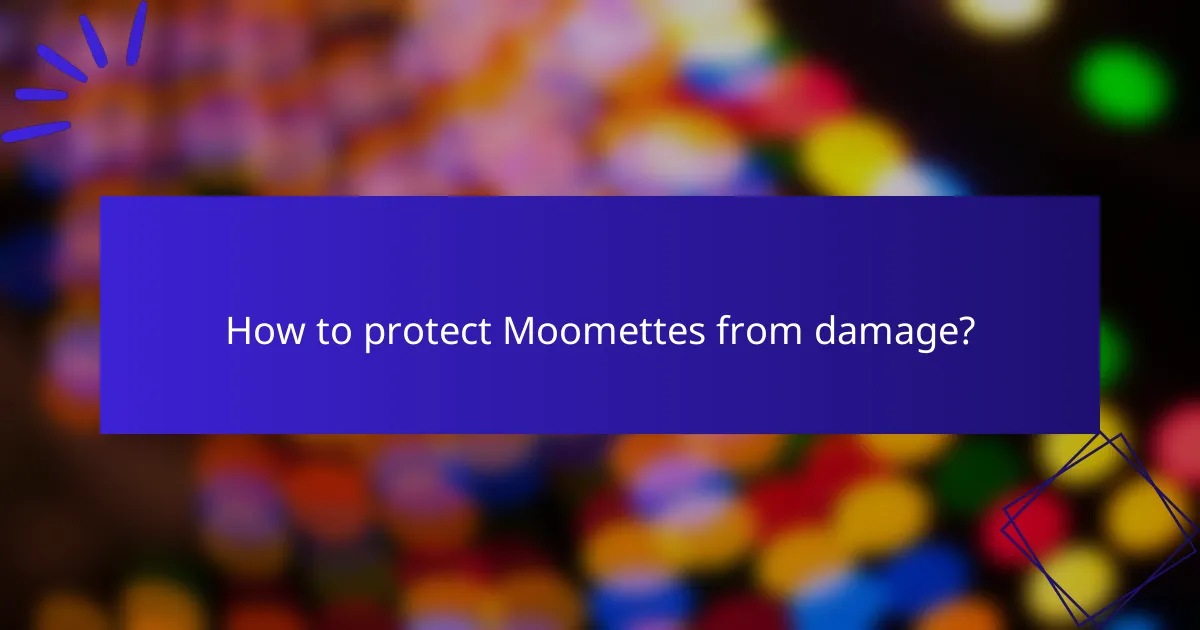Moomettes, cherished for their unique charm, often require specific repairs to address common issues such as wing tears, shell cracks, and color fading. To ensure their longevity and visual appeal, it’s essential to implement protective strategies, including effective coatings and safe storage practices. Regular maintenance, including cleaning and inspections, further enhances their durability and functionality.

What are common Moomette damage repairs?
Common Moomette damage repairs include fixing wing tears, broken legs, shell cracks, color fading, and replacing damaged eyes. Each type of repair requires specific techniques and materials to restore the Moomette to its original condition.
Repairing wing tears
Wing tears can significantly affect the Moomette’s appearance and functionality. To repair these, use a strong adhesive suitable for the material, ensuring the edges are aligned properly. Allow the adhesive to cure fully before handling the Moomette again.
For larger tears, consider reinforcing the area with a patch made from similar material. This adds strength and durability to the repair, helping to prevent future damage.
Fixing broken legs
Broken legs require careful assessment to determine if they can be repaired or need replacement. If repairable, use a strong epoxy or super glue to bond the broken pieces, ensuring they are held in place until the adhesive sets.
If the leg is beyond repair, sourcing a replacement from a manufacturer or a specialized retailer is advisable. Ensure the new leg matches the original in size and material for a seamless restoration.
Addressing shell cracks
Shell cracks can compromise the Moomette’s structural integrity. To address these, clean the crack thoroughly and apply a suitable filler that matches the shell material. Smooth the surface after application to ensure a seamless finish.
For deeper cracks, consider using a reinforcing mesh embedded in the filler for added strength. This technique can help prevent the crack from worsening over time.
Restoring color fading
Color fading can diminish the Moomette’s visual appeal. To restore its vibrant colors, use high-quality paint or dye that is compatible with the Moomette’s material. Test the color on a small, inconspicuous area first to ensure a match.
Applying multiple thin layers of paint can achieve a more even finish than a single thick layer. Allow each layer to dry completely before applying the next to avoid drips and uneven coloring.
Replacing damaged eyes
Replacing damaged eyes is crucial for maintaining the Moomette’s character. Carefully remove the old eye using a craft knife or similar tool, taking care not to damage the surrounding area. Clean the socket thoroughly before inserting the new eye.
Use a strong adhesive to secure the new eye in place, ensuring it is aligned properly. Allow the adhesive to cure fully before handling the Moomette to prevent misalignment.

How to protect Moomettes from damage?
Protecting Moomettes from damage involves using effective coatings, safe storage practices, and selecting durable materials. These strategies help maintain their integrity and extend their lifespan, ensuring they remain functional and visually appealing.
Using protective coatings
Applying protective coatings is essential for safeguarding Moomettes against environmental factors. Coatings such as sealants or paints can create a barrier against moisture, UV rays, and physical wear.
When choosing a coating, consider options that are specifically designed for the material of your Moomettes. For example, a high-quality polyurethane finish can provide excellent durability and resistance to scratches.
Implementing safe storage practices
Safe storage practices are crucial for preventing damage to Moomettes when they are not in use. Store them in a dry, cool environment to avoid moisture buildup, which can lead to mold or deterioration.
Utilize protective covers or padded storage solutions to minimize physical impacts. Avoid stacking heavy items on top of Moomettes, as this can cause warping or structural damage over time.
Choosing durable materials
Selecting durable materials for Moomettes is a proactive approach to damage prevention. Materials like high-density plastics or treated wood can withstand various stresses better than their less robust counterparts.
When making a choice, consider the specific conditions the Moomettes will face. For outdoor use, materials with weather-resistant properties are ideal, while indoor Moomettes may benefit from lighter, more aesthetic materials.

What are effective maintenance strategies for Moomettes?
Effective maintenance strategies for Moomettes involve regular cleaning, seasonal inspections, and proper handling techniques. These practices help prevent damage and extend the lifespan of Moomettes, ensuring they remain in optimal condition.
Regular cleaning routines
Establishing a regular cleaning routine is essential for maintaining Moomettes. Clean them at least once a month to remove dirt, dust, and debris that can cause wear over time. Use mild soap and water, avoiding harsh chemicals that could damage the surface.
Additionally, inspect the cleaning tools to ensure they are non-abrasive. Soft cloths or sponges are ideal, as they prevent scratches while effectively removing grime.
Seasonal inspections
Conduct seasonal inspections to identify any potential issues before they escalate. Check for signs of wear, such as cracks or loose components, and address these problems promptly. Aim to perform these inspections at the beginning of each season to align with changing weather conditions.
During inspections, pay attention to areas that are prone to moisture accumulation, as this can lead to mold or corrosion. Keeping a checklist can help ensure that no critical areas are overlooked.
Proper handling techniques
Using proper handling techniques is crucial to avoid damaging Moomettes. Always lift them carefully, using both hands to distribute weight evenly and prevent strain on any single point. Avoid dragging them across surfaces, as this can cause scratches and other damage.
When storing Moomettes, ensure they are placed in a dry, cool area away from direct sunlight. This will help prevent warping or fading, preserving their appearance and functionality over time.

What tools are essential for Moomette repairs?
Essential tools for Moomette repairs include a variety of adhesives, specialized assembly tools, and cleaning supplies. These tools help ensure effective repairs and maintenance, prolonging the life of your Moomette.
Repair adhesive options
When selecting adhesives for Moomette repairs, consider options like epoxy, cyanoacrylate, and polyurethane. Epoxy offers strong bonding for structural repairs, while cyanoacrylate is ideal for quick fixes on smaller cracks. Polyurethane is flexible and works well for areas that may experience movement.
Always check the manufacturer’s recommendations for compatible adhesives to avoid damaging materials. For best results, apply adhesives in a well-ventilated area and allow adequate curing time as specified on the product label.
Specialized tools for assembly
Specialized tools such as clamps, screwdrivers, and pliers are crucial for Moomette assembly and repairs. Clamps help hold parts in place while adhesives cure, ensuring a secure bond. A variety of screwdrivers can accommodate different screw types commonly found in Moomette designs.
Investing in a quality set of tools can make assembly easier and more efficient. Consider tools that are ergonomically designed to reduce strain during extended use.
Cleaning supplies
Cleaning supplies are vital for preparing surfaces before repairs. Use isopropyl alcohol or a gentle detergent to clean areas that will be glued or assembled. This ensures that dirt and oils do not interfere with adhesion.
Additionally, keep microfiber cloths and brushes on hand for detailed cleaning. Avoid abrasive materials that could scratch surfaces, as maintaining the integrity of the Moomette is essential for effective repairs.

What are the costs associated with Moomette repairs?
The costs of Moomette repairs can vary significantly based on the extent of damage and the specific repairs needed. Generally, homeowners can expect to spend anywhere from a few hundred to several thousand dollars, depending on the situation.
Common types of Moomette damage
Moomette damage can manifest in various forms, including structural issues, pest infestations, and water damage. Each type of damage requires different repair approaches and costs. For instance, structural repairs may involve reinforcing beams or replacing sections of the framework, while pest control may require extermination services and preventive measures.
Factors influencing repair costs
Cost-saving strategies
To manage Moomette repair costs effectively, consider obtaining multiple quotes from contractors to ensure competitive pricing. Regular maintenance can also prevent costly repairs down the line, making it essential to address minor issues promptly. Additionally, exploring local grants or assistance programs may provide financial relief for necessary repairs.
